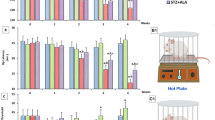Abstract
Distal neuropathy is the most common complication of diabetes mellitus, and it is highly important to reveal the cellular mechanisms leading to its development. In our experiments, neurons of control and streptozotocin-treated diabetic rats were examined. Changes in the intracellular free calcium concentrations ([Ca2+] i ) were fluorometrically measured in primary and secondary nociceptive (dorsal root ganglion, DRG, and dorsal horn, DH, respectively) neurons. The [Ca2+] i elevation was induced by different agents, which can release calcium from the endoplasmic reticulum (ER) calcium stores. The amplitudes of calcium elevation induced by application of caffeine and ionomicine in DRG and DH neurons of diabetic rats were significantly lower, as compared with the control. Application of ATP and glutamate to a Ca-free extracellular solution induced calcium release from the IP3-sensitive store in DH neurons. Release of calcium from the IP3-sensitive ER calcium stores became significantly smaller in neurons from diabetic rats. Taken together, these data indicate that significant changes in the calcium regulating mechanisms of the ER develop under diabetes conditions.
Similar content being viewed by others
REFERENCES
M. J. Millan, “The induction of pain: an integrative review,” Prog., Neurobiol, 57,No. 1, 1–164 (1999).
E. Kostyuk, N. V. Bulgakova, and D. A. Vasilenko, “Parameters of conduction via afferent nerve fibers in mice with streptozotocin-induced and genetically determined diabetes,” Neirofiziologiya/Neurophysiology, 28,Nos. 4/5, 135–143 (1996).
E. Kostyuk and A. Shmigol, “Effect of insulin and nimodipine on calcium signals in murine primary afferent neurons with experimental diabetes,” Neirofiziologiya/Neurophysiology, 27, 270–275 (1995).
N. V. Voitenko, I. A. Kruglikov, E. P. Kostyuk, et al., “Effect of streptozotocin-induced diabetes on the activity of calcium channels in rat dorsal horn neurons,” Neuroscience, 95,No. 2, 519–524 (2000).
E. Kostyuk, N. Pronchuk, and A. Shmigol, “Calcium signal prolongation in sensory neurones of mice with experimental diabetes,” NeuroReport, 6,No. 7, 1010–1012 (1995).
Y. Hattori, H. Kawasaki, M. Kanno, et al., “Attenuated contractile response of diabetic rat aorta to caffeine but not to noradrenaline in Ca2+-free medium,” Eur. J. Pharmacol., 256,No. 2, 215–219 (1994).
J. Z. Yu, G. A. Quamme, and J. H. McNeill, “Altered [Ca2+]i mobilization in diabetic cardiomyocytes: responses to caffeine, KC1, ouabain, and ATP,” Diabetes Res. Clin. Pract., 30,No. 1, 9–20 (1995).
N. Svichar, V. Shishkin, E. Kostyuk, et al., “Changes in mitochondrial Ca2+ homeostasis in primary sensory neurons of diabetic mice,” NeuroReport, 9,No. 6, 1121–1125 (1998).
Author information
Authors and Affiliations
Corresponding author
Rights and permissions
About this article
Cite this article
Shutov, L., Kruglikov, I., Shishkin, V. et al. Calcium Release From the Internal Stores as a Possible Target for Antinociceptive Treatment in Rats with Experimentally-Induced Diabetes. Neurophysiology 34, 230–232 (2002). https://doi.org/10.1023/A:1020736224156
Issue Date:
DOI: https://doi.org/10.1023/A:1020736224156




